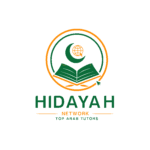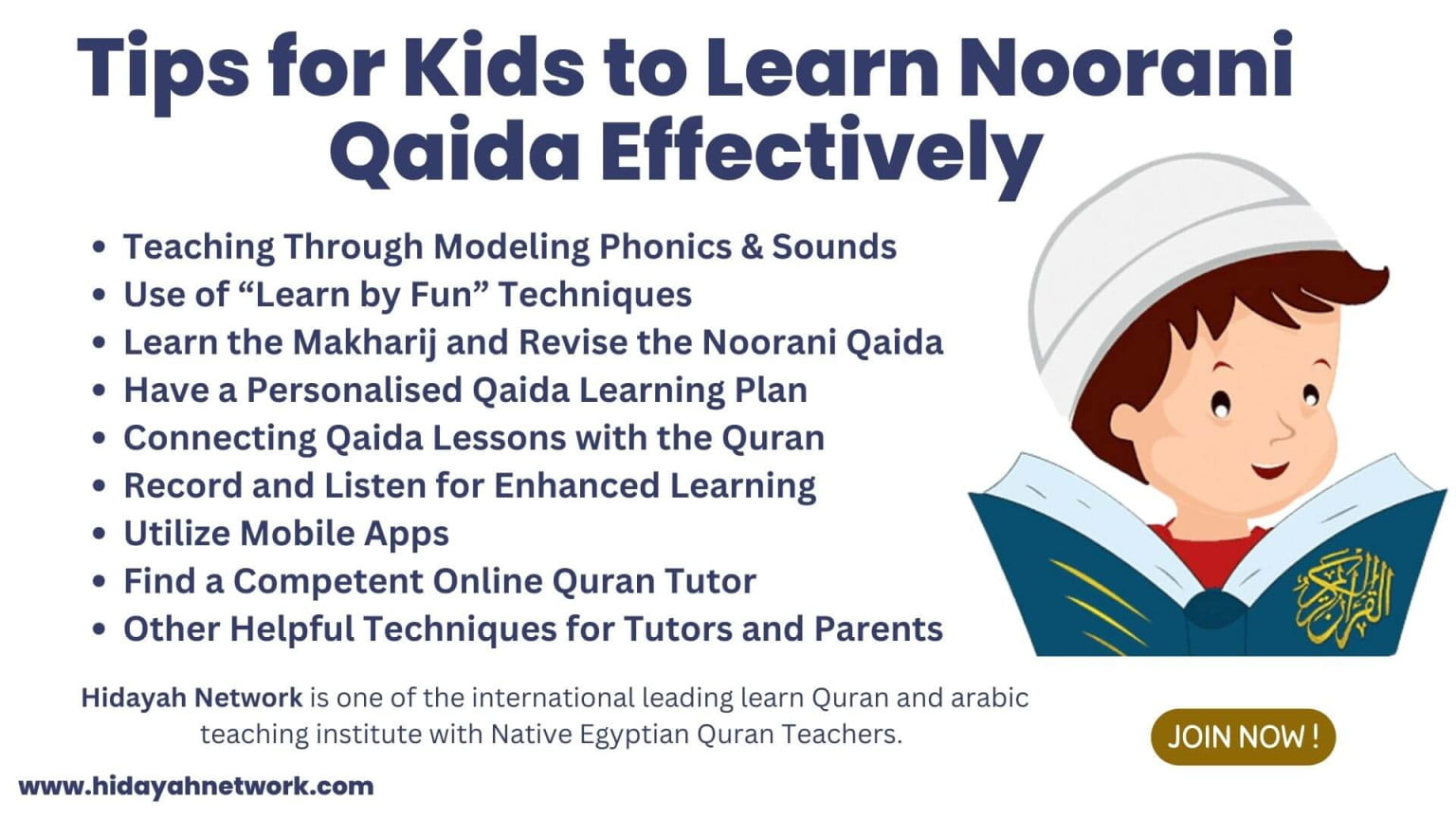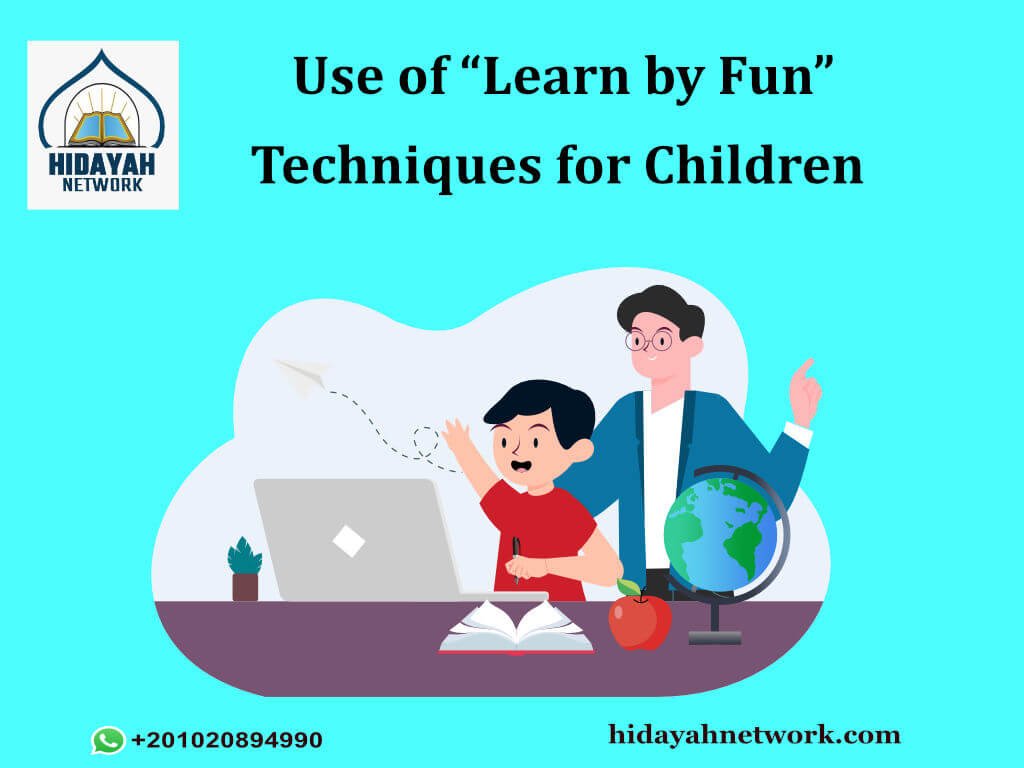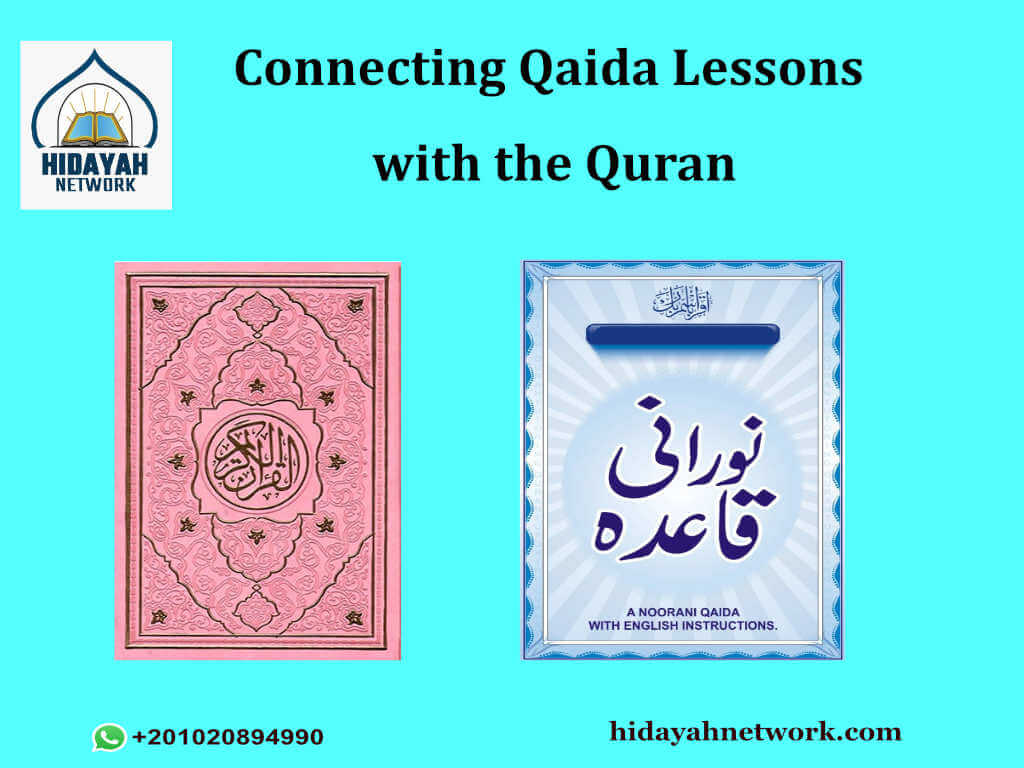How Can Kids Learn Noorani Qaida Effectively?

- Hidayah
- Network
- | Role: Hidayah Network

Are your kids struggling with Arabic phonics and sounds? Do they find it challenging to read the Quran fluently? If so, personalized Qaida plans and learning by fun techniques can help make the Qaida learning process easy for kids.
Teaching Noorani Qaida to kids effectively involves a combination of engaging techniques. These tips encompass phonics, sound modeling, and mastering Makharij pronunciation.
To help children learn this foundational Islamic text, consider methods such as 3D mouth modeling and sound discrimination games. Keep reading to explore additional strategies that make learning Noorani Qaida enjoyable and effective for children.
Table of Contents
Toggle8 Interesting Tips to teach Noorani Qaida to kids Effectively
Let’s explore the exciting journey of learning Noorani Qaida for toddlers and kids.
1. Teaching Kids Through Modeling Phonics & Sounds
Teaching Noorani Qaida to Kids by Modeling Phonics and Sounds: Modeling phonics and sounds is one of the most entertaining techniques to teach Noorani Qaida. These are the most engaging methods for learning Qaida for beginners and make Quranic education fun.
- 3D mouth modeling: Allow learners to understand how sounds are created and articulated by using 3D mouth modeling. So, this educational tool makes learning more engaging and enjoyable.
- Arabic Rhymes: Compose Arabic rhymes using the Noorani Qaida letters and sounds. Rhymes help children remember the letters more quickly and are not merely catchy.
- Articulatory Modeling: Use articulatory modeling approaches to teach children how to pronounce Arabic consonants properly. Accurate pronunciation depends on being able to understand mouth movements.
You can join free Noorani Qaida classes for kindergarten from the Hidayah Network.
2. Use of “Learn by Fun” Techniques for Children

Learning Noorani Qaida can be enjoyable for kids through arts and crafts activities. Use Arabic letter art and interactive flashcards in lessons. Introducing Fun ways to learn Qaida for kids/children keeps them engaged for a longer time.
Learning Qaida Enjoyable for kids through Arts and Crafts
Parents can use arts and crafts to make their Noorani Qaida journey enjoyable. So, these home activities include
- Making a personalized Dua book
- Building a Kaaba model
- Making Quran covers and decorating
- Writing verses and them beautifully
- Adding a list of Surahs they understand to their scrapbook
- Making bookmarks and Islamic stickers
Pictorial dictionaries and visuals enhance learning. Arts and crafts make Quran learning fun for kids. Arabic calligraphy and Quranic interest are promoted.
Get 40% OFF Now!
Alphabet Sound Discrimination Games
Kids love games. So, help kids identify letter sounds using activities. Interactive exercises make alphabet learning fun.
In addition, kids can make them do whatever they want as part of the game. Make it a game to get a child to complete his food and boom! Incorporate learning into the game. So, use learn through fun techniques like:
- Challenge them to learn their lesson within a set timeframe.
- Create a treasure hunt by hiding solid stickers in their Noorani Qaida to find during sabaq.
- Also, create engaging, interactive quizzes.
Thus, learning Noorani Qaida online with apps and games is the most effective way to learn fast. Interactive digital tools can improve learning.
3. Learn the Makharij and Revise the Noorani Qaida
Every letter in Arabic has a different pronunciation. Therefore, it makes the word pronunciations challenging to memorize.
Children can perfect 17 lessons of Qaida only with Makharij practice. Kids should practice Makharij and learn vocabulary frequently. They should focus on learning Makharij and using it when reciting the Quran.
Kids will learn Makharij faster by reciting the Quran with perfect tajweed. Children should learn and apply tajweed with parental guidance.
Kids should practice Noorani Qaida and revise it daily to learn it. Revision helps youngsters recall lessons, and they can only go forward when they do. Further, practice new Noorani Qaida lessons and revise previous ones as a habit for kids. Kids who learn simultaneously each day are more able to concentrate on Tajweed and retain lessons.
4. Have a Personalised Qaida Learning Plan
Personalized Qaida plans help your kids achieve Noorani Qaida goals. It keeps your kid on track and focused on improvement.
Hidayah Network provides customised and organized learning in Online Noorani Qaida classes for kids. In fact, it is skillfully built to fulfill all learners’ demands, especially beginners.
Setting an Effective Time-table for Effective Learning
A customized Qaida strategy is essential for mastering Arabic reading basics. Customize your Qaida learning plan. Create a timeline that matches the child’s focus for optimal learning.
Kids may lose focus if they learn the Noorani Qaida before playing. So, you must create an excellent timetable to help them learn. Ideas include:
- Early morning learning sessions
- Noorani Qaida class before lunch
- Learning Noorani Qaida at Asr-Maghrib time
- Revision before bedtime
Thus, setting a good learning schedule is important in teaching Qaida to toddlers effectively.
Expert tip: Mirror practice helps toddlers visualize their lip movements when pronouncing Arabic consonants. They improve their pronunciation.
5. Connecting Qaida Lessons with the Quran

Learning Noorani Qaida and connecting its lessons to the Quran is enjoyable for kids. It is just like solving a magnificent Quranic puzzle.
Let’s examine two effective techniques to connect Qaida’s lessons to the Quran.
Practice Relevant Words of Qaida in the Quran: As you study Noorani Qaida, you’ll meet Arabic words and sounds closely related to the Quran. Teach kids Quranic examples. In addition, this will boost learning speed and effectiveness. Kids can detect pronunciations and tajweed by studying Quranic examples. It will help them apply tajweed rules.
Practice Short Verses of the Quran: Learn and study the Quran’s short verses (ayat) as hidden wealth. The Arabic letters and sounds from your Noorani Qaida are often in these lines. Learn Qaida-related verses first.
6. Record and Listen for Enhanced Learning
Imagine studying and developing your Noorani Qaida abilities just by listening. In fact, you can! Audio recording and listening have developed into powerful tools for improved learning in our digital age. This method can advance your learning to read Quran for kids.
Using an Audio Recorder:
- Recording one’s own recitations allows for self-evaluation.
- For guidance, ask your teacher to record your recitations.
- For self-evaluation and progress, record practice sessions and play them back.
Utilize Mobile Apps:
- Explore interactive apps for learning the Quran that are made for Noorani Qaida instructions.
- Find apps that offer recordings of verses from the Quran recited by well-known Qaris.
- For inspiration, pay attention to well-known Qaris like Sheikh Sudais and Sheikh Mishary Rashid.
7. Find a Competent Online Quran Tutor
Firstly, choose an Arabic Tutor. Native Arabic language proficiency is a major reason to hire an Arab Quran teacher. Arab teachers teach Noorani Qaida very well. So, your kid will learn the correct pronunciation and Tajweed rules.
Secondly, enroll in a course. Follow a Structured Learning Program by Hidayah Network. These programs serve as roadmaps for your Noorani Qaida and Quranic journey. Their good online Quran tutor will lead you through a well-organized Noorani Qaida curriculum. Additionally, their systematic technique builds a solid basis from basic Arabic letters to complicated tajweed rules.
Lastly, send your kid to any institution for a one-on-one Noorani Qaida class. Effective learning requires personalized attention. A qualified online Quran tutor provides customized instruction, immediate feedback, and assistance. This individualized technique deepens your understanding and accelerates Noorani Qaida’s expertise.
8. Other Helpful Techniques for Tutors and Parents
We have help techniques that handle the issues while learning Noorani Qaida with Tajweed for children:
- Pronunciation & smoothness: Use tongue twisters and encourage louder speech to tackle smoothness. Moreover, if necessary, seek the advice of a speech therapist to help with pronunciation and fluency.
- Difficulty overcome while learning: Address challenges with mouth motions, articulatory modeling, and regular practice.
- Focus Issue: Keep lessons brief, including storytelling. Also, show patience and encouragement as students progress through their studies.
In short, Kids can enjoy learning the Quran with customized Qaida plans, arts and crafts, and exciting methods. Your child’s Arabic reading skills can also improve with a qualified native online Quran tutor.
Encourage your kids to practice the Makharij of the terms daily. Moreover, revise the Noorani Qaida daily and make Quran listening a habit. These strategies will help your kids learn Arabic and enjoy the Quran.
Conclusion
In short, Kids can enjoy learning the Quran with customized Qaida plans, arts and crafts, and exciting methods. Your child’s Arabic reading skills can also improve with a qualified native online Quran tutor.
Encourage your kids to practice the Makharij of the terms daily. Moreover, revise the Noorani Qaida daily and make Quran listening a habit. These strategies will help your kids learn Arabic and enjoy the Quran.
Most Important FAQs
The time it takes to learn Noorani Qaida varies. It typically ranges from 6 weeks to 2 months. Thus, it totally depends on factors like prior knowledge, study frequency, age, teaching method, and personal dedication.
To make Noorani Qaida engaging for kids, use colorful visuals and interactive games, set achievable goals, relate lessons to real life, and incorporate Quranic storytelling.
There are many fun ways to learn Qaida for children. Use colorful, interactive materials, keep lessons short, practice with Arabic rhymes and games, or join the Hidayah Network.
Choose kid-friendly Qaida books with clear explanations, establish a regular lesson schedule, or enroll them in Hidayah Network’s Arabic or Quranic classes with qualified instructors.

About Author
